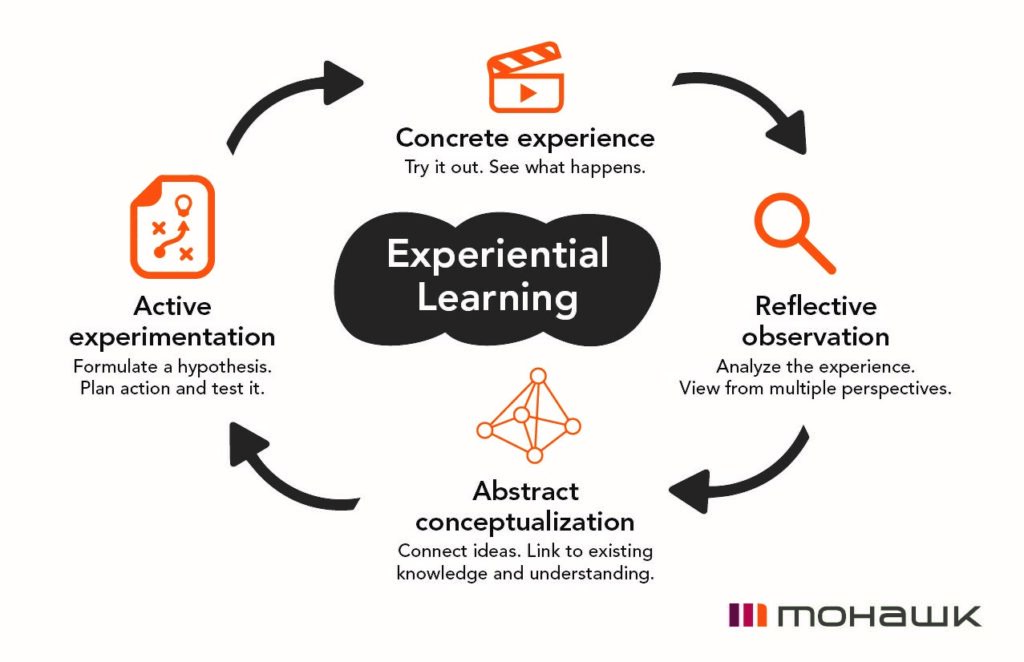
Experiential learning theory centers around learning through experiences or learning by doing. This kind of learning provokes critical thinking, problem-solving, and using a guess and check method is an intuitive way for humans to learn. Through researching this topic I found many resources cited David A. Kolb, an American psychologist and educational theorist (Cherry, 2020, March 12). Kolb’s theory contains four main phases in what he named the experiential learning cycle: concrete experience, reflective observation, abstract conceptualization, and active experimentation (Mohawk College, n.d.).

Experiential learning moves students through a continuous cycle approach to learning (EPM, 2020, October 2). Starting at the top middle of the image above, a learner has an experience (concrete experience). Then they reflect on the experience (reflective observation). Next, students form an understanding of the concept being learned, often making connections to prior knowledge (abstract conceptualization). Then students consider how their actions created or influenced the outcome, what they can do to change or better the outcome and the cycle continues (active experimentation). Through this process of practice, reflection, understanding, and repetition (Sprouts, 2015, October 15) students are able to learn more about a topic each time they move through the cycle.
I found that this video is helpful for teachers who want to incorporate experiential learning into their classrooms by not only outlining the theory but also how this can apply to students and classroom settings.
I also found this short (13 minute) podcast on experiential learning. The guest on this episode is Jenny Einzig, an intermediate teacher, who speaks to how she has included experiential learning inside and outside of her classroom.

The Interactive Learning Resource that my learning pod is creating is for a grade three math class. We have built-in several instructional approaches but experiential learning is highlighted in the hands-on activities using rulers to measure/find the perimeter of objects or shapes on worksheets. Experiential learning aligns with our grade three math resource (measurement and perimeter) because students need to manipulate objects and rulers to gain an understanding of how to complete this task. For example, students will start by using rulers to find the length/length of each side of an object (concrete experience). Then they will check their answers with a teacher or peer (reflective observation). Next, they take into account feedback they received and connect it to prior knowledge to form understanding (abstract conceptualization). Finally, they will continue using the ruler to measure/find the perimeter of other objects, or if their answer was incorrect they will try again with the first object and the cycle continues (active experimentation).
Lastly, I would like to mention that Kolb’s theory of experiential learning is connected to his theory of learning styles. While it can be tempting to sort students into learning style groups this theory has been criticized as there is not enough evidence to support the idea of learning styles (Cherry, 2020, May 15). Maintaining a classroom environment where there are several approaches to course content delivery ensures that each students’ needs can be addressed.
References:
Cherry, K. (2020, March 12). Biography of psychologist David Kolb. Verywell Mind. https://www.verywellmind.com/david-kolb-biography-2795505
Cherry, K. (2020, May 15). Kolb’s theory of learning styles. Verywell Mind. https://www.verywellmind.com/kolbs-learning-styles-2795155
EPM. (2020, October 2). Kolb’s learning cycle explained with example [Video]. YouTube. https://www.youtube.com/watch?v=rycjUldMl3k
Mohawk College. (n.d.). Experiential learning theory. https://www.mohawkcollege.ca/employees/centre-for-teaching-learning/experiential-learning/experiential-learning-theory
Sprouts. (2015, October 15). Experiential learning: How we all learn naturally [Video]. YouTube. https://www.youtube.com/watch?v=aF63HHVbpQ8